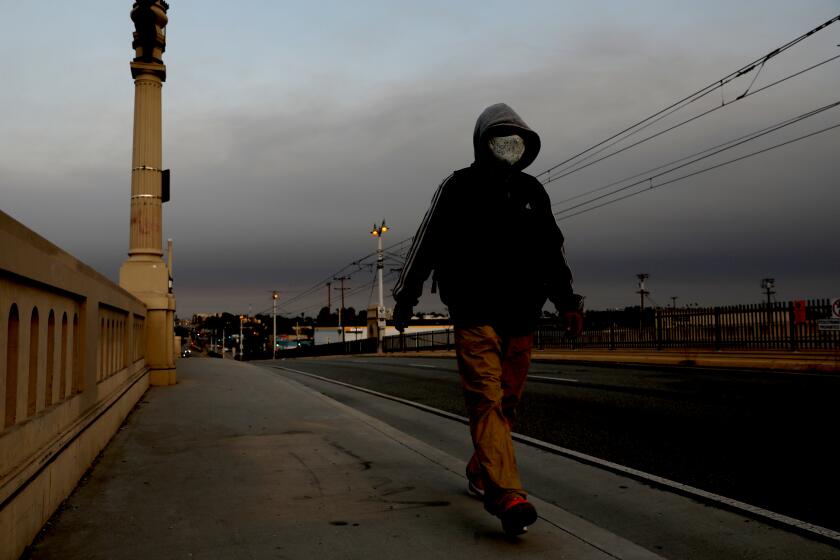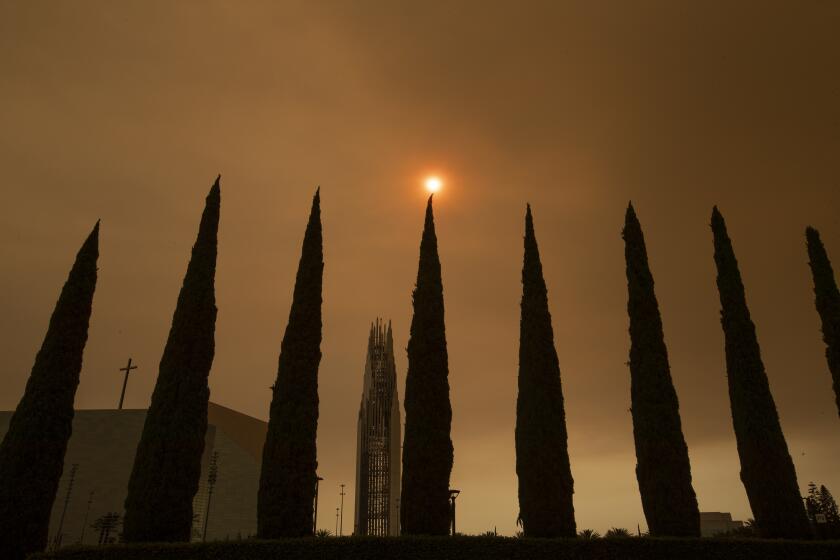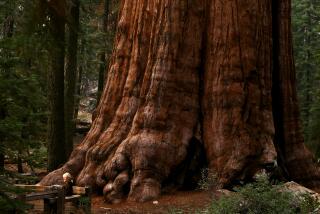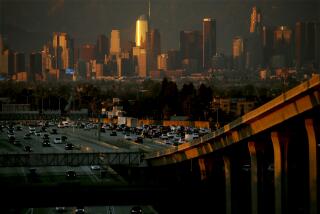‘Brutal’ smog from fires to worsen L.A. air, prompting some to weigh relocating

Adam Ho often asks himself why he lives in Los Angeles — its prices prevent him from buying a home or traveling as much as he dreams or entertaining to his delight.
“In the beginning, it was the culture and the music, the pop-up food and the nightlife,” said the aficionado of downtown L.A., an out-of-work waiter. “These days, it’s COVID, peer pressure to wear or not wear masks, more fires than you ever imagined, and, man, the smog is brutal.”
For several days now, the South Coast Air Quality Management District issued unhealthful air advisory due to smoke and ash from two major local fires, as well as wildfires racing across Central and Northern California. The air is sparking challenges to residents the minute they step outdoors, not to mention leaving trails of smoke heading south, affecting vast swaths of land in the L.A. Basin.
People are advised to avoid outdoor activities at least into Sunday, with unhealthy air quality reported Saturday across the L.A. Basin and inland valleys. Air quality was somewhat better in Orange County.
The Bobcat fire exploding north of Azusa and Monrovia in the Angeles National Forest, with a burn area of more than 30,000 acres, was only 6% contained as of Saturday, according to officials. The fire continues to burn into the forest, which is good news for foothill communities that have been poised to evacuate if the winds shift. But many evacuation warnings remain in place.
Crews spent Saturday working the southern lines, trying to protect homes in Monrovia, Arcadia, Azusa and other communities.
Meanwhile, the El Dorado fire leaping up the San Bernardino Mountains near Yucaipa, spanning nearly 14,000 acres, was 31% contained Saturday.
RELATED: The Updated Air Quality Map for Southern California
Both infernos pumped out substantial amounts of smoke, with the district’s monitoring equipment measuring hourly values in the “unhealthy” to “hazardous” air quality index categories since Thursday evening. Southern California is also still dealing with smoke driven into the basin by fires to the north, some as far away as Washington state.
Fires are leaving ash particles small enough to be detected by the South Coast AQMD’s PM10 monitors, according to the advisory. The AQMD is forecasting that areas south of Bobcat along the I-10 corridor from Pasadena to Rancho Cucamonga “will likely see the highest particulate-matter levels, as smoke is likely to remain closer to the ground overnight” Friday. Moreover, onshore winds were expected to start around noon Saturday, moving smoke north and northeast into the mountains of Los Angeles, Riverside and San Bernardino counties.
The air around Southern California feels like smoke soup because of wildfires. What does that mean for your health and daily routines?
Air quality has continued to nosedive across Southern California, with the looming smoke creating a plume up and down the West Coast stretching more than 1,000 miles wide, said Philip Fine, deputy executive officer of the South Coast AQMD.
Ho, who has started tracking air quality, has downloaded apps onto his phone to stay in the know and was reading up on multiple blazes as he texted friends, trying to decide whether to share Thai takeout over the weekend.
“If we’re practical, we should stay in. And as long as I’m in front of the screen, I might as well check housing prices in more affordable places,” he said. He’s thinking he should research a move to a less costly locale, such as Arizona.
The smoke advisory for much of the region is likely to remain in effect through the weekend, the South Coast Air Quality Management District says.
Angie Cisneros, too, has thought about leaving California, for Louisiana or, better yet, Utah, since she would love to be close to the beguiling red rocks of the Bryce Canyon and Zion national parks. The Echo Park store clerk said it saddened her “not to see a single cloud” while driving around L.A. Thursday and Friday.
“This is not the scene we see in the magazines when we think of the City of Angels,” she said. “Somehow, we have to take better care of our environment to come back to those bright, beautiful photos. But really, these fire tragedies made me rethink why I want to be here.”
Cisneros said she’s “very scared” of weather conditions that will spread more ash over areas where she and her extended family in San Bernardino County live.
“Unhealthy” or higher air quality index ratings due to PM2.5 concentrations — tiny, soot-producing particles that can be damaging to the lungs — were expected to vary throughout Saturday, affecting parts of Los Angeles, Orange, Riverside and San Bernardino counties, according to the AQMD.
“I’m totally stressed out,” Cisneros added. “You go out to the car, and it’s like extra icing that no one needs to eat. I’m tired of all the unexpected extras in California.”
Here are tips for managing during times of poor air quality:
- Stay indoors, if possible.
- Keep windows and doors closed.
- Check local public health alerts and the Southern California air quality map.
- Find an air-conditioned place, like a designated L.A. County Cooling Center.
- Take extra precautions to protect people with heart or lung disease (including asthma), the elderly and children, as they may be more likely to experience poor health if they breathe wildfire smoke.
- Avoid vigorous physical activity.
- Run your air conditioner if you have one. Make sure it has a clean filter and that it is recirculating the indoor air to prevent bringing additional smoke inside.
- Create a clean air space in your home by using a portable air cleaner instead of or in addition to your air conditioner. Do this in one or more rooms with the doors and windows closed.
- Avoid using a whole-house fan or swamp cooler with an outside air intake.
- Avoid using indoor or outdoor wood-burning appliances, including fireplaces and candles.
- Do not rely on “dust masks” for protection. Paper masks can block large particles such as sawdust but do not protect lungs from the small particles or gases in wildfire smoke. Disposable respirators such as N-95 or P-100 respirators can offer some protection if they are worn properly and have a tight fit.
Times staff writers Hayley Smith and Tony Barboza contributed to this report.
More to Read
Start your day right
Sign up for Essential California for news, features and recommendations from the L.A. Times and beyond in your inbox six days a week.
You may occasionally receive promotional content from the Los Angeles Times.








